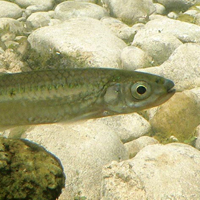Silver shiner
Scientific name: Notropis photogenis

Cover photo credit: Al Dextrase
Status
Threatened
"Threatened" means the species lives in the wild in Ontario, is not endangered, but is likely to become endangered if steps are not taken to address factors threatening it.
Date added to the Species at Risk in Ontario List
January 13, 2012
What it looks like
Silver shiner is a relatively large, slender minnow that can grow to about 14 centimetres long. It has a silvery body with some blue or green iridescence, a dark stripe down the centre of the back, and a long snout marked with two black crescents between the nostrils. All of the fins are transparent or white with no spots or other distinctive markings.
Where it lives
Silver shiners prefer moderate to large size streams with swift currents that are free of weeds and have clean gravel or boulder bottoms. They live in schools and feed on crustaceans and adult flies that fall in the water or fly just above the surface. In June or July, they spawn by scattering their eggs over gravel riffles.
Where it’s been found in Ontario
The Silver shiner range includes east-central North America throughout the Ohio and Tennessee River drainage basins. In Ontario, it is found in the Thames and Grand Rivers, and in Bronte Creek and Sixteen Mile Creek, which flow into Lake Ontario.
View a larger version of this map (PDF)
What threatens it
Dam construction and channelling of streams, as well as water pollution, may have caused historic declines of Silver shiner in Ontario. Agricultural and urban land use, sportfish stocking, bait fish harvesting, and habitat loss and degradation are also threats. Temperature may be the most important limiting factor, as southern Ontario represents the northern limit for the species.
Action we are taking
Threatened species and their general habitat are automatically protected under Ontario’s Endangered Species Act, 2007.
Recovery strategy
A recovery strategy advises the ministry on ways to ensure healthy numbers of the species return to Ontario.
Read the executive summary and the full document (July 12, 2023).
Government response statement
A government response statement outlines the actions the government intends to take or support to help recover the species.
Read the government response statement (April 17, 2024).
General habitat descriptions
General habitat descriptions are technical, science-based documents that provide greater clarity on the area of habitat protected for a species.
Read the general habitat description.
What you can do
Report a Sighting
The Ministry of Natural Resources and Forestry tracks species at risk. You can use a handy online form to report your sightings to the Natural Heritage Information Centre. Photographs with specific locations or mapping coordinates are always helpful.
Volunteer
Volunteer with your local nature club or provincial park to participate in surveys or stewardship work focused on species at risk.
Be a good steward
Private land owners have a very important role to play in species recovery. You may be eligible for stewardship programs that support the protection and recovery of species at risk and their habitats.
Report illegal activity
Report any illegal activity related to plants and wildlife to
Quick facts
- The Silver shiner is common and abundant in the centre of its North American range but less common and more likely to be considered at-risk at the edge of this range, particularly in Ontario, New York, Michigan, Alabama and Georgia.
- Silver shiners are sexually mature at age two, and most reach a maximum age of three years.
- Silver shiners are easily confused with Emerald shiners and Rosyface shiners, which may have contributed to the fact that they were only confirmed in Canada in 1973, but may have always been present.
